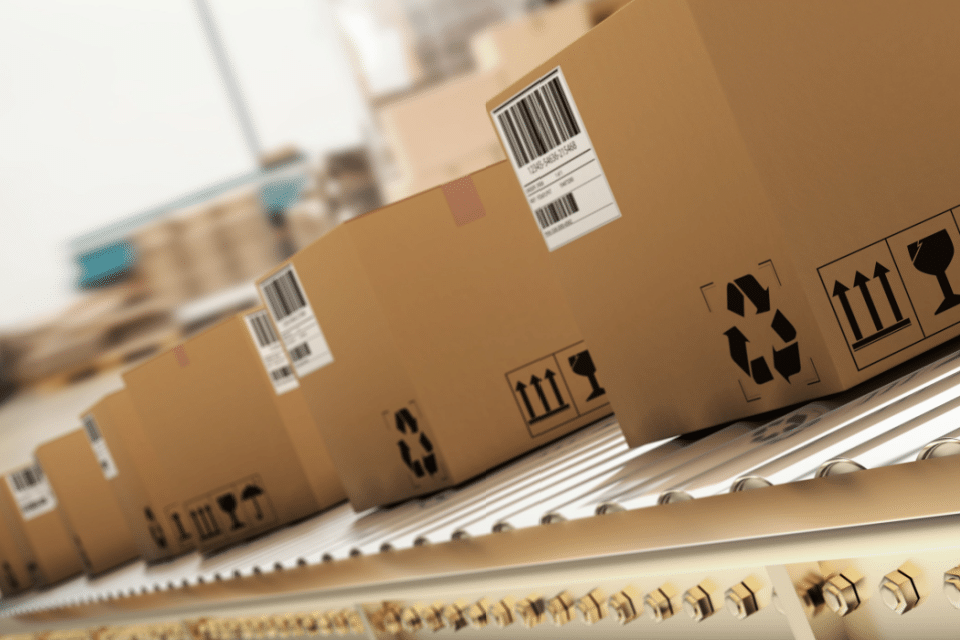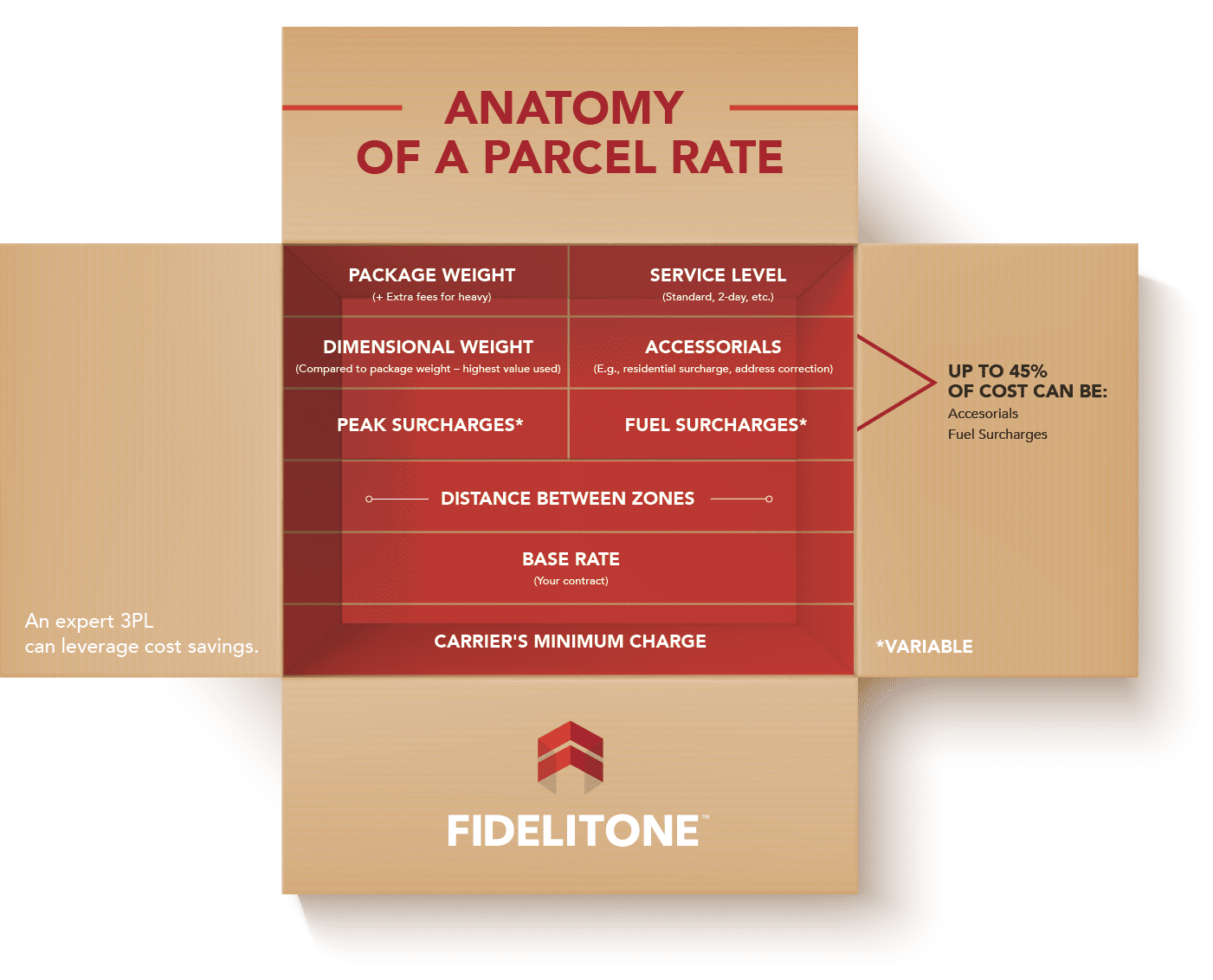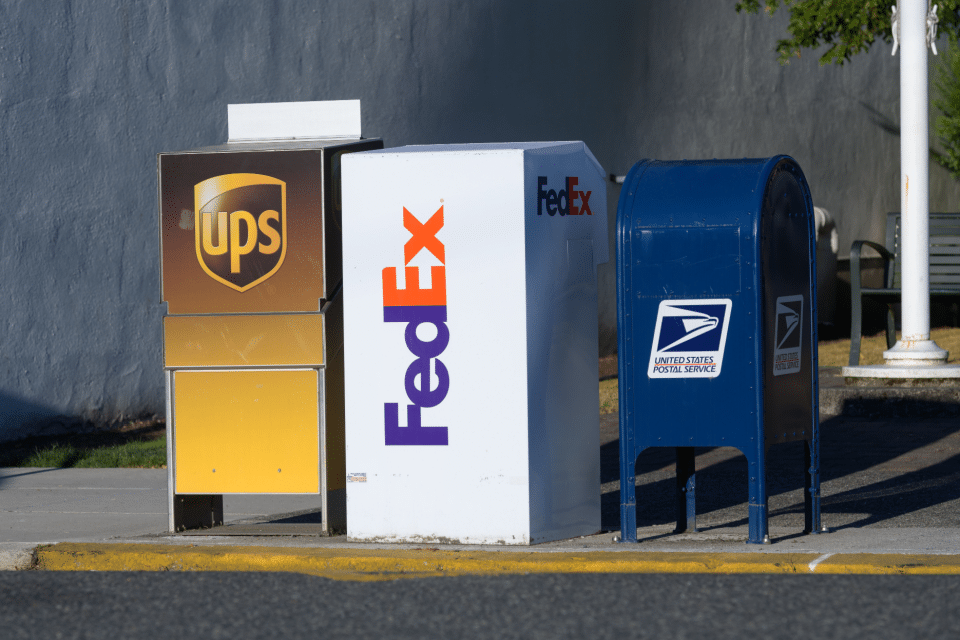Anatomy of a Parcel Rate – Insights for Parcel Cost Management

Rising shipping rates can erode the profits of online and omnichannel retailers. In fact, “the cost of shipping is the No. 1 challenge for e-commerce merchants today,” says Supply & Demand Chain Executive. If you are seeking strategies to reduce shipping costs, a great starting place is understanding the anatomy of a parcel rate, as reducing parcel delivery charges and improving parcel rate management can have significant impact on profitability.
This guide breaks down the many factors that affect your costs and offers insight into how parcel pricing experts and third party providers can help manage and reduce them.

Base Rate
Effective parcel cost management begins with understanding your base rate. The base rate for shipping parcels is based on published rate structures from the carrier or your negotiated contract. Every service has a zone and weight matrix with specific costs. The base rate applies to every parcel. In 2025, both UPS and FedEx have $11.32 as the published rate for a 1lb shipment going to zone 2. A consideration also needs to be made for absolute minimums. Every carrier agreement comes with minimums – the lowest cost per package that you will pay. Minimums can be negotiated, and they are an important piece of the puzzle as discounts won’t matter if your minimum is higher than your combined discounts.
Note that one advantage of working with a third party order fulfillment service with high economies of scale is that they will likely be able to negotiate the most favorable base rate, with up to a 30-50% discount off published rates depending on the service. There is also the earned discount which is a shipping volume based discount calculated on a 52 week rolling average.
The factors outlined below add on to the base rate for your final parcel shipping cost.
Distance between zones
The distance between the origin of your parcel and its final destination is determined by how many geographic zones the package travels through. More zones usually mean higher parcel delivery charges.
Using published FedEx Ground as an example, a shipment that weighs 3 lbs going to zone 2 shipment would cost $12.57 as of June 2025. This same shipment to zone 7 would cost $17.20. Generally speaking in the U.S., each 300 miles from the origin denotes another zone and higher cost. Although this is a rule of thumb, each carrier has its own zone/zip code structure. If you are serving a large geographic area, attention to zones can be a crucial factor in managing your shipping costs.
Practical Ecommerce suggests a careful look at where you locate warehousing and order fulfillment operations. Business.com advises, “If you’re not big enough to maintain facilities throughout the country, using an order fulfillment company with a regional, national, or international infrastructure lets you utilize their bulk delivery discounts, resulting in lower shipping costs for your customers.”
A free order fulfillment network analysis from FIDELITONE can reveal the optimal strategy for your order fulfillment to minimize zone-related shipping costs.
Accessorial fees
Accessorials, extra fees added to the base rate, can sometimes account for more than 20% of the total shipping costs. There are dozens of these fees. Examples of UPS published surcharges include residential delivery ($5.50) , remote area delivery ($7.15), large package ($135-$170), additional handling ($16.50 – $34.50), and address correction ($19.50), to name a few. Understanding how accessorials factor into your parcel rates is key to successful parcel rate management. Accessorial fees are complex, and pricing may be dynamic, making it challenging for shipping managers to control and optimize final costs. This is another advantage of working with a third party order fulfillment service, as they will likely be able to negotiate a discount of up to 30-50% off published rates, depending on the surcharge.
Peak surcharges
Peak surcharges are fees added for seasonal surges, such as holiday shipping. However, peak periods can be extended by carriers. Most peak surcharges take the form of a flat fee per package added to the base rate. Peak surcharges typically impact brands with an eCommerce sales channel and can present a significant impact to costs. Common peak surcharges include:
- Demand Surcharges
- Delivery Area Surcharges
As an example, in 2024 the FedEx residential delivery area surcharge was $5.85 per package, while remote area surcharge was $14.25 per package. There is also the oversized and large package surcharge that can be up to $500 for packages that are oversized or heavy.
Peak season surcharges are critical to understand and prepare for. The holiday season is often a time for brands to maximize sales and revenue, but peak season surcharges can quickly erode profitability if not handled well.
Fuel surcharge
Parcel carriers add a fuel surcharge that is adjusted weekly based on national fuel indices. Air and ground services have different fuel indices, which are tied to different fuel—jet fuel for air, and diesel for ground. For example, as of June 8, 2025, the fuel surcharge for ground services for FedEx is 17.75%; see the FedEx weekly fuel surcharge specification for details. This surcharge is applied regardless of distance or weight of the shipment and can account for 10%-20% of the overall cost of the shipment.
The fuel surcharge can change at any moment, not just during the annual GRI (general rate increase). Carriers state “fuel surcharge percentages and associated trigger points are subject to change without notice” and as an example, FedEx announced a fuel surcharge increase effective June 9 2025. Parcel rate reduction efforts should include contingency planning for fuel increases, as well as focusing on other areas of cost optimization that can help offset the cost of fuel surcharge increases. Being prepared for unplanned increases is paramount.
Dimensional weight
A carrier may charge for parcel weight based on actual weight or dimensional weight, whichever is higher. Dimensional weight is based on the length X weight X height of the box, the DIM. It accounts for the space a package will take up in transit, and it affects total costs. “Dimensional weight reflects package density, which is the amount of space a package occupies compared to its actual weight. Dimensional weight may apply to all UPS domestic and international package services,” explains UPS. This is distinct from actual weight.
Each carrier has a DIM divisor they apply to the length X weight X height figure to determine dimensional weight. For example, USPS uses a divisor of 166. They divide the DIM by 166 to determine how many pounds the package “weighs” for billing purposes. FedEx currently uses a DIM divisor of 139, which means the same package would come out with a higher “weight” for billing. The higher the divisor, the lower the calculated weight. Knowing the DIM divisor for carriers helps you compare and manage shipping costs effectively. A major advantage of working with a 3PL is their buying power over the DIM divisor. This figure is typically negotiated, and a third party can typically provide a higher divisor, further reducing parcel pricing and resulting in significant cost savings.
Also be aware of the total shipment going out to a carrier. “For multiple-package shipments, total the billable weight of all packages in the shipment,” explains UPS. Rather than handling packages as one-offs, working with a fulfillment service that can manage the sum-total of shipping requirements also has the potential to save costs.
Needless to say, smaller, more efficiently packed boxes can affect shipping costs, too. “Reducing packaging can make shipments more environmentally friendly by helping lower fuel emissions, and can help you avoid overpacking, which wastes material,” says FedEx.
Cartonization technology, which uses algorithms to specify the smallest dimensions possible for each order being fulfilled, is one of the solutions FIDELITONE uses to secure the lowest possible shipping costs for order fulfillment clients.
Package weight
Actual weight of a package, if higher than dimensional weight, will determine the billable weight used by carriers to determine shipping fees. Smaller, heavier packages may appear to cost less but the weight will actually cause costs to increase. Keep in mind that carriers typically also charge accessorial fees for heavy packages. As an example, for packages over 50 lbs will incur a “additional handling” surcharge which is calculated based on zone. The additional handling fee can be excessive, but fortunately accessorial like this are eligible for discounts if negotiated effectively.
Service level
How quickly do you want your packages to reach your customers? The cost differences between next-day or two-day versus routine or ground can be significant. For example, as of June 2025, a shipment weighing 5 pounds going to zone 3 on FedEx Standard overnight is $64.20 versus the same shipment going Ground Economy ($14.76) or Home Delivery ($20.71), all before the fuel surcharge.
Customers may expect quick fulfillment of their orders, but they also seek out free shipping. Businesses must evaluate their parcel cost management strategy to determine how to best balance service level expectations with overall shipping expenses. Reducing parcel rates may involve extending delivery windows or optimizing fulfillment processes. (Learn how to balance service and cost in the blog, 5 Choice to Optimize Your Ecommerce Fulfillment Strategy.)
As you consider service speed to the customer, keep in mind that processes count. Order cycle time is more than just shipping speed. For example, initiating order fulfillment faster once the order has been received can make the difference between shipping it out today versus tomorrow. Having the right technology integrations in place can shorten order cycle time.
Likewise, working with a fulfillment provider who processes orders and uses shipping cutoffs that are later in the day can make a difference. Attention to these order fulfillment details can be specified in your order fulfillment SLAs.
Navigate the shipping cost conundrum with parcel pricing experts
With shipping cost calculations being dynamic and complex, reducing your shipping costs is no easy task. To understand the impact of shipping cost factors and evaluate options on your business, consider working with an expert who can analyze your parcel data, geography, packaging, service options, and more to leverage the best possible shipping solution through one or a combination of carriers – including regional carriers.
The bottom line is that managing shipping costs can protect your profits. Contact us today for a free consultation and discover how to reduce parcel delivery charges through expert parcel cost management.
FIDELITONE helps you earn customers’ loyalty through specialized services in inbound logistics, order fulfillment, last mile delivery and service parts management.



